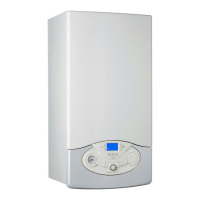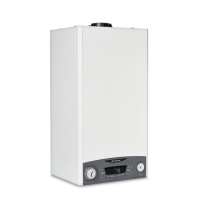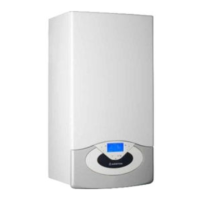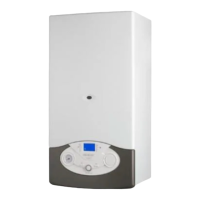43
maintenance
Draining the System
Draining the Heating System
The heating system must be drained as follows:
- Turn off the boiler;
- Attach a hose pipe and open the drain valve;
- Drain the system at the lowest points (where present). When
the heating system is unused for an extended period of time, it
is recommended that you add antifreeze with an ethylene glycol
base to the water in the heating pipe work and radiators if the
ambient temperature drops below 0°C during the winter.
This makes repeated draining of the entire system unnecessary.
Draining the Domestic Hot Water System
Whenever there is the danger of the temperature dropping below
the freezing point, the domestic hot water system must be drained
as follows:
- Turn off the general water valve for the household plumbing
system;
- Turn on all the hot water taps;
- Empty the remaining water from the lowest points in the
system (where present).
Completion
For the Republic of Ireland it is necessary to complete a “Declaration
of Conformity” to indicate compliance to I.S. 813. An example
of this is given in the current edtion of I.S. 813. In addition it is
necessary to complete the Benchmark Log Book.
Operational Checks
1. The fl ue system must be visibly checked for soundness.
2. On Central Heating allow the system to warm up and
manipulate the Central Heating temperature control knob,
check the burner modulates up and down between the high
and low settings.
3. Range rate the thermal power for Central Heating, as detailed
on page 30.
4. Run the Domestic Hot Water, manipulate the Domestic
Hot Water temperature control knob to check the burner
modulates up and down between the high and low settings
(COMBI only).
5. Balance the Central Heating system until all return
temperatures are correct and equal.
6. Switch ON/OFF button OFF, disconnect the pressure Gauge,
retighten screw and relight boiler.
7. Re-examine Central Heating, Domestic Hot Water and Cold
Water supplies for soundness.
8. Check the appearance of the gas fl ame to assess the adequacy
of the combustion air supply.
9. If external controls have been disconnected, reconnect and
test.
10. Refi t boiler casing.
11. Complete the Benchmark Commisssioning Checklist on page
46 and any other necessary documentation.
Instructing The End User
1. Hand over the copy of the End User Instructions supplied with
the appliance, together with these instructions, and explain
how to use the timeclock and room thermostat if fi tted.
2. Show the End User how to switch the appliance off quickly, and
indicate the position of the electric supply isolator.
3. Inform the End User of the location of all drains, isolating valves
and air vents.
4. Explain how to turn the appliance off for both short and long
periods and advise on the precautions necessary to prevent
damage in the event that the appliance is inoperative when
freezing conditions occur.
5. Finally advise the End User that, for continued safe and effi cient
operation, the appliance must be serviced by a competent
person at least once a year.
It is recommended that the following inspections be carried out
on the boiler at least once a year:
1 - Check the seals for the water connections; replace any
faulty seals.
2 - Check the gas seals; replace any faulty gas seals.
3 - Visual check of the entire unit.
4 - Visual check of the combustion process or analysis of
combustion by-products (see Section 3.4) and cleaning of
the burner if needed.
5 - If necessary, dismantling and cleaning of the combustion
chamber.
6 - If necessary, dismantling and cleaning of the burner jets.
7 - Visual check of the primary heat exchanger:
- check for overheating in the blade assembly;
- clean the exhaust fan if needed.
8 - Adjustment of the gas pressure, gas rate and soft-light,
partial load and full load.
9 - Check of the heating safety systems:
- safety device for maximum temperature (overheat
thermostat);
- safety device for maximum pressure (safety valve).
10- Check of the gas safety systems:
- safety device for lack of gas or fl ame ionisation (detection
electrode).
11- Check of the electrical connection (ensure it complies with
the instructions in the manual).
12- Check of Domestic Hot Water production effi ciency (fl ow
rate and temperature)
13- General check of the combustion by-products of the
discharge/ventilation system.
14- Check of the general performance of the unit.

